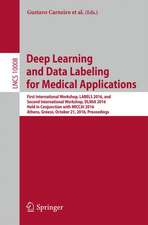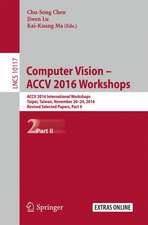Precision Landmark Location for Machine Vision and Photogrammetry: Finding and Achieving the Maximum Possible Accuracy
Autor José A. Gutierrez, Brian S.R. Armstrongen Limba Engleză Hardback – 23 oct 2007
This book addresses the problem of measurement error associated with determining the location of landmarks in images. The least possible photogrammetric uncertainty in a given situation is determined using the Cramér–Rao Lower Bound (CRLB).
This monograph provides the reader with: the most complete treatment to date of precision landmark location and the engineering aspects of image capture and processing; detailed theoretical treatment of the CRLB; a software tool for analyzing the potential performance-specific camera/lens/algorithm configurations; two novel algorithms which achieve precision very close to the CRLB; a method for determining the accuracy of landmark location; a downloadable MATLAB® package to assist the reader with applying theoretically-derived results to practical engineering configurations.
| Toate formatele și edițiile | Preț | Express |
|---|---|---|
| Paperback (1) | 584.59 lei 38-44 zile | |
| SPRINGER LONDON – 13 oct 2010 | 584.59 lei 38-44 zile | |
| Hardback (1) | 645.47 lei 6-8 săpt. | |
| SPRINGER LONDON – 23 oct 2007 | 645.47 lei 6-8 săpt. |
Preț: 645.47 lei
Preț vechi: 806.83 lei
-20% Nou
Puncte Express: 968
Preț estimativ în valută:
123.53€ • 128.49$ • 101.98£
123.53€ • 128.49$ • 101.98£
Carte tipărită la comandă
Livrare economică 12-26 aprilie
Preluare comenzi: 021 569.72.76
Specificații
ISBN-13: 9781846289125
ISBN-10: 1846289122
Pagini: 172
Ilustrații: XI, 162 p. With online files/update.
Dimensiuni: 155 x 235 mm
Greutate: 0.42 kg
Ediția:2008
Editura: SPRINGER LONDON
Colecția Springer
Locul publicării:London, United Kingdom
ISBN-10: 1846289122
Pagini: 172
Ilustrații: XI, 162 p. With online files/update.
Dimensiuni: 155 x 235 mm
Greutate: 0.42 kg
Ediția:2008
Editura: SPRINGER LONDON
Colecția Springer
Locul publicării:London, United Kingdom
Public țintă
ResearchCuprins
Physics of Digital Image Formation.- Analytic Framework for Landmark Location Uncertainty.- Model-based Landmark Location Estimators.- Two-dimensional Noncollocated Numerical Integration.- Computational Tools.- Experimental Validation.- Studies of Landmark Location Uncertainty.- Conclusions.
Notă biografică
José A. Gutiérrez is Principal Engineer at the Innovation Center of Eaton Corporation, leading the technical activities in Wireless Sensor Networks. He received the B.S. degree in electronic engineering from Universidad Simon Bolivar in Caracas, Venezuela, in 1991, and the M.S. in electrical engineering from the University of Wisconsin - Milwaukee in 2001. Currently he is a Ph.D. candidate at the same institution. Mr. Gutiérrez is an active member of the IEEE LAN/MAN Standards Committee and Editor in-Chief of the IEEE 802.15 Working Group, Task Group 4, focused in the development of Low-Rate Wireless Personal Area Networks. His areas of expertise include control systems, wireless communication, networking, information theory, bioelectronics, and standards development. He has two patents filed and is author of several papers in the areas of automatic control, artificial intelligence, and wireless communications.
Textul de pe ultima copertă
The applications of image-based measurement are many and various: image-guided surgery, mobile-robot navigation, component alignment, part inspection and photogrammetry, among others. In all these applications, landmarks are detected and located in images, and measurements made from those locations.
Precision Landmark Location for Machine Vision and Photogrammetry addresses the ubiquitous problem of measurement error associated with determining the location of landmarks in images. With a detailed model of the image formation process and landmark location estimation, the Cramér–Rao Lower Bound (CRLB) theory of statistics is applied to determine the least possible measurement uncertainty in a given situation.
This monograph provides the reader with:
• the most complete treatment to date of precision landmark location and the engineering aspects of image capture and processing;
• detailed theoretical treatment of the CRLB;
• a software tool for analyzing the potential performance-specific camera/lens/algorithm configurations;
• two novel algorithms which achieve precision very close to the CRLB;
• an experimental method for determining the accuracy of landmark location;
• downloadable MATLAB® package to assist the reader with applying theoretically-derived results to practical engineering configurations.
All of this adds up to a treatment that is at once theoretically sound and eminently practical.
Precision Landmark Location for Machine Vision and Photogrammetry will be of great interest to computer scientists and engineers working with and/or studying image processing and measurement. It includes cutting-edge theoretical developments and practical tools so it will appeal to research investigators and system designers.
Precision Landmark Location for Machine Vision and Photogrammetry addresses the ubiquitous problem of measurement error associated with determining the location of landmarks in images. With a detailed model of the image formation process and landmark location estimation, the Cramér–Rao Lower Bound (CRLB) theory of statistics is applied to determine the least possible measurement uncertainty in a given situation.
This monograph provides the reader with:
• the most complete treatment to date of precision landmark location and the engineering aspects of image capture and processing;
• detailed theoretical treatment of the CRLB;
• a software tool for analyzing the potential performance-specific camera/lens/algorithm configurations;
• two novel algorithms which achieve precision very close to the CRLB;
• an experimental method for determining the accuracy of landmark location;
• downloadable MATLAB® package to assist the reader with applying theoretically-derived results to practical engineering configurations.
All of this adds up to a treatment that is at once theoretically sound and eminently practical.
Precision Landmark Location for Machine Vision and Photogrammetry will be of great interest to computer scientists and engineers working with and/or studying image processing and measurement. It includes cutting-edge theoretical developments and practical tools so it will appeal to research investigators and system designers.
Caracteristici
Shows the reader how to derive theoretical limits to the precision of landmark identification in electronic images MATLAB® package assists the reader with applying theoretical results in real engineering systems Steps outside the usual earth-sciences and civil-engineering base of photogrammetry to improve animation, medical imaging and robotic vision applications Includes supplementary material: sn.pub/extras


















